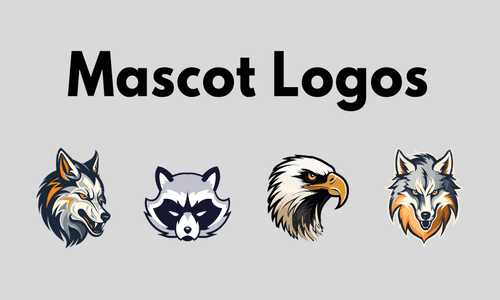People don’t remember brands. They remember faces. Even when that “face” has fur, antennae, or a goofy, oversized smile.
That’s the entire cheat code behind a great mascot logo. It goes past logic and connects directly to emotion.
If you’re ready to create your own mascot logo, this guide explains the mascot logo meaning with examples and walks you through the process in practical steps.
What is a Mascot Logo?
A mascot logo is a brandmark that includes an illustrated character. This could be a person, an animal, a cartoon figure, or any creative character that reflects the brand’s personality. The mascot logo definition usually includes pairing this character with the brand’s wordmark logo so people can easily connect the visual with the business name. Because the character essentially becomes the “face” of the brand, it helps audiences quickly recognize and remember the business whenever they see its products, social posts, or messages.
Why Choose a Mascot Logo Design for Your Brand
Mascot logos help your audience feel more connected to your brand over the long term. And there’s plenty of research to support the importance of the mascot logo for businesses.
1. Higher Profit and Emotional Impact
A study from the Moving Picture Company found that mascots can boost profit and emotional engagement by up to 41%. They also make brands 37% more competitive. In other words, mascots help your brand stand out and engage customers on a deeper level.
2. Better Attention and Recall
A study published in Research Space shows that 59.5% of people pay more attention to brands with mascots. Another 56.7% find it easier to recall brands that have mascots or characters. Needless to say, mascots make your brand more noticeable and memorable.
3. Greater Market Share Growth
Research by global marketing research firm System1 reveals that campaigns using mascots can increase market share by 37%. This makes it clear that mascots strengthen marketing performance and help brands grow faster.
Mascot Logo Types (with Famous Brand Examples)
Your brand identity and target audience play an important role in determining the best mascot design. There are several common types of logos to consider. To help you visualize, here are some relevant mascot logo examples with the names of their brands.
1. Animal Mascot Logos
Animal mascot logos are based on real or stylized animal characters. And since most people associate animals with specific qualities, these types of brand marks can communicate the brand’s personality more effectively.
Think about Duolingo’s owl mascot logo, for example. Duo pops up in friendly, expressive poses that push users to stay motivated as they learn new languages.

Or look at the World Wildlife Fund’s panda, a calm and instantly recognizable symbol that naturally reinforces the organization’s mission to protect endangered species.

On the contrary, Lonsdale uses a walking, roaring lion mascot logo. Now, that’s the perfect way to project strength and courage for its boxing and martial arts audience.

Tiger mascots are also used in the fashion world. Kenzo’s tiger mascot logo includes the tiger head, paired with “Kenzo Paris.” It embodies a fierce energy suitable for the bold and exotic feel the brand is known for.

2. Cartoon Mascot Logos
Cartoon mascots are expressive and, therefore, instantly feel approachable. Even when the character style is playful, it can still be a smart move to use it to make your brand experience feel more human.
KFC does this well with its stylized portrait of Colonel Sanders, complete with his bow tie and warm smile. It showcases the brand’s familiar and welcoming personality.

Similarly, in Pringles, Julius Pringle portrays a lighter and fun-first personality. It has a round face, mustache, and upbeat expression to match the brand’s cheerful snack identity.

Another example is Mailchimp’s smiling Freddie the Chimp. It’s a minimal hand-drawn mascot that makes the platform feel accessible and less corporate while still aligning with its mission to simplify email marketing.

Reddit keeps things quirky with Snoo, the alien. This character is identified by an antenna and bright eyes. These features align with the site’s tech-driven and community-powered personality.

3. Vintage Mascot Logos
Vintage logo designs are inspired by illustration styles from the early 20th century. So they naturally give off a nostalgic feel. But more importantly, brands using this style of mascots feel more established and more trustworthy. Industries like automotive, snacks, and beverages usually use these retro mascot logos.
A classic example is Michelin’s Bibendum. Made of stacked tires, this oversized figure represents the brand’s mission to provide sustainable mobility solutions.

Planters is another great example. The company’s mascot, Mr. Peanut, is a dapper humanlike peanut. It personifies the brand’s mission of being premium and always “A Nut Above.”

4. Educational Mascot Logos
Educational mascots include the school or college mascot logos. These focus on school identity and spirit, which could be fun and friendly for younger students or fierce and commanding at the college level. Famous mascot logos in education are usually symbolic animals or illustrations that rally students and sports team fans.
For example, Boston College has a dynamic eagle mascot logo. It is the perfect symbol of their pride on campus and in games. The same can be seen in the bear mascot logos of Baylor University. The American Black Bear perfectly showcases the strength and spirit of the university.

5. Sports Mascot Logos
Sports mascots are quite similar to university mascot logos, but they are specifically used to represent a team’s strength and competitive energy. These can be powerful animals, mythical creatures, or action-oriented human figures driving the visual story.
You can see these in gaming team mascot logos. For example, the Carolina Panthers use a panther mascot logo. It shows a snarling panther head that captures the team’s fierce presence in the NFL. Similarly, the Minnesota Timberwolves use a wolf mascot logo. The howling wolf is set against a subtle forest backdrop – a perfect representation of the untamed spirit of the northern wilderness.

By examining these mascot logo design examples, you can identify the key elements of a successful brand logo. These can help you create the ideal character for your own business.
Key Design Elements of Successful Mascot Logos
Successful brand mascot logos aren’t created randomly. They materialize the very essence of the brand. At the same time, they resonate with the target audience and stick in people’s minds.
But what exactly makes a mascot logo style unique? Here are the golden rules of logo design to be aware of.
- Instantly Recognizable: A well-designed mascot will stand out the moment you see it. Simple shapes and clean lines help it maintain its appeal at any size and in any format. Even without color, it should be readable.
- A Personality That Matches the Brand: A mascot’s tone and attitude need to feel intentional and consistent. Whether it’s playful, calm, bold, or refined, the character should communicate what the brand stands for.
- Flexible and Easy to Adapt: A mascot should work seamlessly across all formats, sizes, and applications. It must stay recognizable when fully illustrated or shrunk down into an icon.
- Builds Human Connection: Expressive features and storytelling cues help make a mascot logo feel more alive. It should be able to increase trust in your brand and encourage more engagement.
- Designed to Last, Not Follow Trends: Trendy styles age quickly. Your mascot should be timeless and remain a meaningful symbol as the brand evolves. You can still make small updates to make sure your logo doesn’t feel outdated.
Definitely check out modern logo design examples to know how logo designs have evolved over the years.
How to Make a Mascot Logo Your Audience Will Remember
Creating the best mascot logos is a strategic process. You need to understand what your brand stands for and how to use visual storytelling to embody its very essence in your character.
A successful mascot logo design process includes the following steps.
Step 1. Know Who You’re Competing
Before you start the design process, take a look at your competition. This will help you design a character that is unique to your brand and does not blend in. Moreover, once you notice the mascot logo trends in your industry, you can align your character to your industry’s design expectations.
When researching your competition:
- Analyze the character types, design elements, and color palettes.
- Identify the recurring elements and avoid those as they can feel predictable.
- Brainstorm what your mascot can do differently to avoid being generic.
- Outline ideas that make your brand genuinely different.
Step 2. Understand Your Brand’s Core Values
At this stage, you will know exactly how to distinguish your mascot from your competition. Now, you need to align your mascot’s personality to your brand’s mission and purpose. This will affect how people perceive your brand and guide the tone you want to communicate. When you’re clear about these principles, you can make your mascot logo design feel more intentional.
Ask yourself these questions to establish your core values:
- What are the top three qualities people should associate with your brand?
- What does your brand offer emotionally, not just functionally?
- How are people already describing your business?
- Which personality do you want your brand to project?
Once you have your answers, you can envision how your mascot’s personality should look and feel.
Step 3. Give Your Mascot a Strong Personality
Mascots go beyond just drawing a fun character. You want it to have a personality that conveys your brand’s message without saying a word. For example, you might use the personification of a fox to represent your brand as clever or wise. But the way you portray it changes everything.
Instead of a plain fox character, it could look cheerful, brooding, sarcastic, or mischievous – whatever best describes your brand. Think about how you want people to feel when they see it. And let those traits guide the character’s overall behavior and tone.
Step 4. Choose a Character That Fits Your Brand
After deciding how your brand should feel, you need to establish what it should look like. You can draw mascot logo inspiration from any character, like an animal, a cartoon, or a fantasy figure. But whatever you choose, make it fit your brand identity.
While you will only use a specific part of the mascot in the logo, like a face drawing or the character’s silhouette, later on, it can take the form of a 3D character to use in your marketing materials. So, design the character’s entire personality, from its actions to its tone, to keep everything consistent and streamlined.
Step 5. Sketch Out Your Ideas
At this point, you will have a solid foundation to kickstart the design process. Start by sketching your mascot logo ideas. And while you do that, be as creative as possible. Don’t focus on getting it right or knowing exactly what you want to create.
Sketching would be your creative playground to explore and brainstorm ideas freely. Draw out different poses, costumes, and expressions. These will help you get a complete picture of how your character should behave. You can also look at the logo sketches of famous brands for inspiration.
Step 6. Choose a Color Palette
After you’ve done your drawings, choose a color palette that fits your mascot’s personality. Colors are a powerful tool to communicate a certain image of your brand. Popular mascot logos always choose their palettes intentionally. Just remember that whatever colors you use, make sure they align with your brand’s primary color palette.
Step 7. Make Your Design Unique
Drawing the character is only one part of the equation; the design itself should be singular enough to be memorable. So, think outside the box. Go for exaggerated shapes or oversized elements like large glasses or shoes, and out-of-proportion limbs or belly.
But since you would need to combine the mascot with your brand’s wordmark, avoid complex shapes. Keep your design simple and legible. The overall design of the character should make people feel something. At the same time, it should align with your brand identity.
Final Words
A well-designed mascot logo brings your brand’s story and values to life. But it takes strategy, clear branding insight, and a series of intentional design choices. The process can get detailed and a little overwhelming, which is why an expert mascot logo maker can make a huge difference.
At PNC Logos, we help brands like yours design memorable mascot logos that resonate with your audience and carry your brand’s story. Contact us today to bring your mascot ideas to life!





